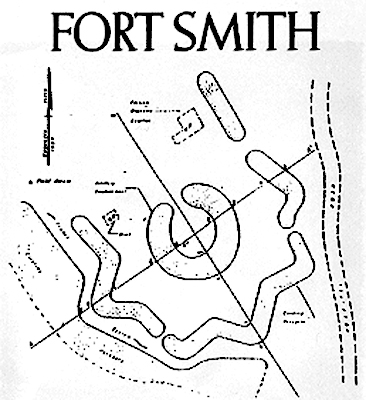|
Fort Smith boasts one of finest examples
of earthen fortifications in Kentucky
When Confederate Gen. Gideon Pillow moved into and fortified Columbus, the Union army realized it was facing a severe threat.
Despite the Kentucky State Legislature’s declaration of neutrality in May 1861, the Confederacy made a move north into the Commonwealth from Tennessee. It was a major claim-staking maneuver.
With Columbus becoming a southern stronghold, Union Gen. U.S. Grant moved his troops into Cairo, Ill., and took the town in three days. He then moved into Paducah, which extinguished any hopes Kentucky had of avoiding the Civil War. Once in Paducah, Grant order construction of Fort Anderson and then Fort Smith at Smithland.
 Kentucky now had no choice but to claim allegiance to one side or the other. The legislature’s decision, despite many Confederate sympathies, was to remain in the Union. With Confederate troops stationed at Columbus, the government of Kentucky immediately began to raise troops to force the Confederate army to leave. Kentucky now had no choice but to claim allegiance to one side or the other. The legislature’s decision, despite many Confederate sympathies, was to remain in the Union. With Confederate troops stationed at Columbus, the government of Kentucky immediately began to raise troops to force the Confederate army to leave.
Now bound to the Union, forts were constructed to house and recruit soldiers.
Smithland was chosen for its strategic location, situated at the confluence of the Cumberland and Ohio Rivers. Both waterways would lead to major campaign areas – the Cumberland leading south into Tennessee and Fort Donelson; the Ohio leading into the Mississippi River and the Naval campaign that cut the South in half.
Fort Smith, an encampment and fortification complex, was constructed in September 1861 and would serve its purpose until the last regiment there was mustered out of service in November 1865. The star-shaped fortifications at Smithland – one of the finest examples of earthen fortifications in Kentucky – were separated by a half mile of rolling river bluffs. One gun emplacement guarded the confluence of the Ohio and Cumberland Rivers while the other guarded the floodplain that surrounded them.
The northern gun emplacement was protected by both a 32- and 64-pound cannon and housed the Union encampment and rifle pits. The southern gun emplacement was a 32-pounder that covered the southern and western flanks and the roads to Tilene and Gilbertsville. It was located on Cemetery Hill and behind what is now Livingston Central High School.
The fort became an important supply depot and staging area for Grant’s upcoming campaigns. It was garrisoned throughout the war by various regiments, including the 13th U.S. Colored Heavy Artillery.
On Sept. 5, 1861, four companies from the Illinois 12th Regiment Infantry under the leadership of Gen. C. F. Smith were the first to arrive at Smithland. Others from their group were stationed at Fort Anderson. On Sept. 8, Companies “B” and “I” separated from the 41st Regiment Infantry at Paducah and were stationed at Fort Smith.
On Jan. 31, 1862, C. F. Smith received orders from Gen. Grant to take all of the command from Smithland, except the 52nd Illinois, to Fort Henry. After the victories at Forts Henry and Donelson, captured Confederates were to be sent north to Chicago. One of the first stops on the route north was Smithland. What Lew Wallace described as a mostly quiet town was enraged at the sight of the tattered and torn prisoners in gray.
On July 8, 1864, defense of Fort Smith was turned over to the 13th Heavy Artillery Colored Regiment, which had garrisoned with others at Camp Nelson and “other points in Kentucky.” They remained at Fort Smith until mustered out of service on November 18, 1865.
Once a bustling port, Smithland is reputed to be the oldest incorporated town on the Ohio River. It’s also the county seat of Livingston County. The Smithland Heritage Tour and Civil War Re-enactment is held every year during the first weekend in May at Livingston Central High School. The event also features a narrated walking tour. For more information, call the Smithland Chamber of Commerce (270) 928-2446.
|







